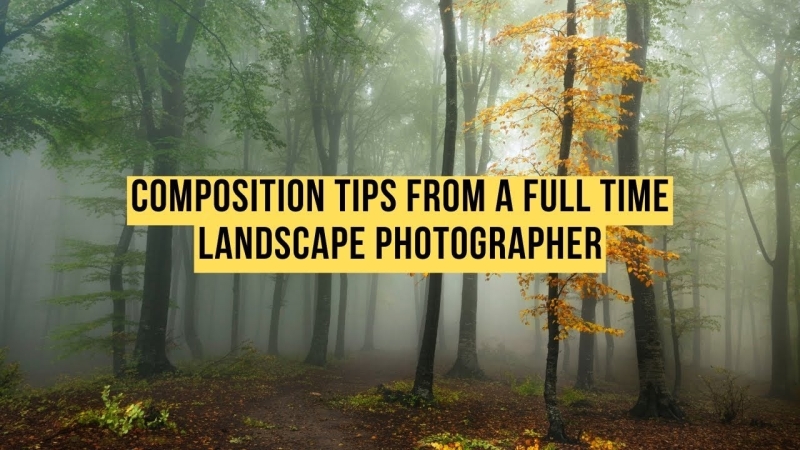We’ve all been there: you’re in the wilderness, faced with an absolutely jaw-droppingly beautiful scene stretching as far as the eye can see. The light is perfect; it is simply breathtaking. You snap a few photos with your wide-angle lens, thinking that it will look as stunning as you’re seeing with your own eyes. You eagerly download the photos when you get home,e and your bubble bursts. They are somewhat lacklustre and there’s no focal point, there’s nothing to guide your eye around the landscape. It is super disappointing.
But don’t worry—that’s exactly why composition rules exist. Being in a beautiful landscape simply doesn’t automatically translate to a beautiful landscape photo. Sure, there are lucky accidents, but usually, we have to learn to take great photographs, and it takes time and practice. In this excellent video, landscape photographer Toma Bonciu walks us through why he thinks composition is so important in photography, particularly for landscapes.
Why Composition Matters
During a landscape photography workshop, one of the photographers asked Toma a simple yet profound question: “Why do we need composition in our photography?” Toma’s initial response was straightforward: composition helps organize nature’s elements in a way that the viewer’s brain can understand, creating a visual map that leads to the subject.
However, the follow-up question challenged his perspective: “If I’m here enjoying the landscape, why does the viewer need composition?”
This moment was a turning point for Toma. He realized that while photographers are fully immersed in the landscape, experiencing it with all their senses, the viewer has no connection to the scene. This disconnection is why composition is crucial. It bridges the gap, helping the viewer navigate the photo and connect with the subject. It’s all about transporting the viewer into the scene and helping them understand the emotions that the photographer experienced at the time the photo was taken.
Five Essential Composition Rules
Toma emphasizes that while there are many composition rules, five stand out as particularly important. Here’s his breakdown, complete with actionable tips and personal anecdotes:
1. The Rule of Thirds: A Starting Point, Not a Rule
The rule of thirds is often the first composition technique photographers learn. It involves dividing the frame into thirds horizontally and vertically, then placing the subject along these lines or at their intersections. Toma, however, sees it more as a placement suggestion than a rigid rule.
For example, in a foggy forest scene, Toma placed an orange tree on one of the thirds, using the fog to eliminate clutter and highlight the subject. But he cautions against over-reliance on this rule. If the horizon line is placed exactly in the middle, the image can feel static. Instead, he recommends placing it above or below the centre to create more interest.
Pro Tip: Break the rule of thirds when the scene demands it. If the sky or foreground is particularly striking, adjust your composition to emphasize those elements.
2. Leading Lines: Guide the Viewer’s Eye
Leading lines are a powerful tool for directing attention. Toma stresses the importance of experimenting with your position, both horizontally and vertically, to find the best composition. He often scouts compositions using just his phone before setting up his tripod.
In one instance, while photographing a waterfall, Toma noticed a tree growing horizontally, creating a natural leading line. He positioned himself low to the ground to emphasize this line, which was further accentuated by light and shadows. The waterfall, with its high contrast and luminosity, became the focal point where the leading lines converged.
Pro Tip: Leading lines don’t need to physically intersect. Imagine their paths meeting, and place your subject near that intersection for maximum impact.
3. The S-Curve: Add Dynamic Perspective
The S-curve is a classic composition technique that adds depth and movement to an image. Toma demonstrated this during a photo tour in Tuscany, where he photographed a winding road under dramatic skies. By positioning himself to one side, he created a diagonal that led the viewer’s eye through the frame, enhancing the sense of perspective.
Pro Tip: Look for natural curves in landscapes, such as rivers, roads, or paths. Use them to create a visual journey that draws the viewer into the scene.
4. Depth and Layers: Create a Sense of Scale
Adding layers to your composition helps convey depth and scale. Toma often uses foreground elements, like pine trees, to establish perspective. In a shot from the Dolomites, he used darker shadows in the foreground and lighter tones in the background to separate layers, making the mountains appear grander.
Pro Tip: Use familiar objects in the foreground, like trees or rocks, to help viewers gauge the size of the landscape. This creates a storytelling element, as the brain fills in the gaps to understand the scene.
5. Frame Within a Frame: Focus Attention
Framing your subject within natural elements, like arches or trees, adds depth and directs the viewer’s attention. Toma often uses this technique in forests, where trees on either side of a trail create a natural frame. In one example, he photographed a church through an archway, using the structure to isolate the subject and eliminate distractions.
Pro Tip: Be mindful of competing elements. If multiple frames or high-contrast areas distract from the subject, adjust your position to simplify the composition.
Final Thoughts
Toma’s approach to composition is both practical and intuitive. He encourages photographers to experiment, break rules when necessary, and always consider the viewer’s perspective. By mastering these techniques (rule of thirds, leading lines, S-curves, depth and layers, and framing), you can create compelling images that resonate with your audience. Check out the full video below:

